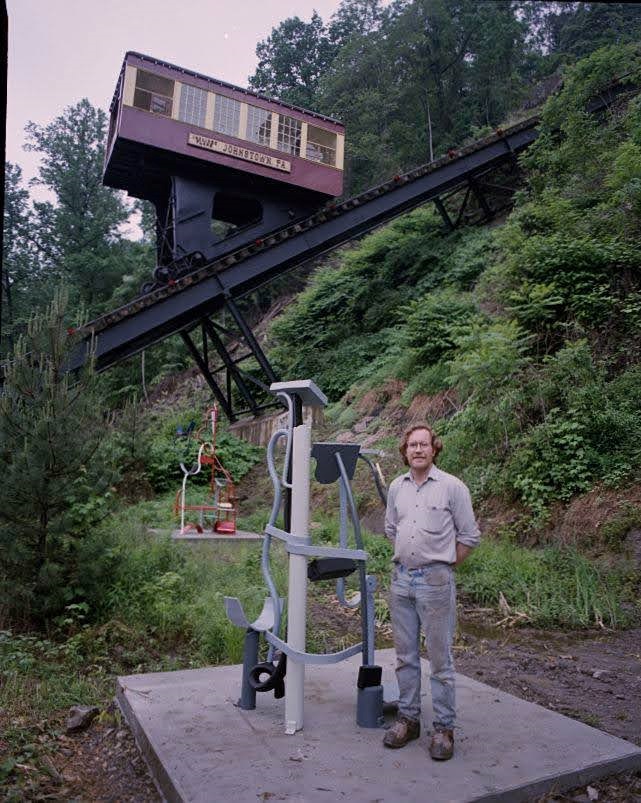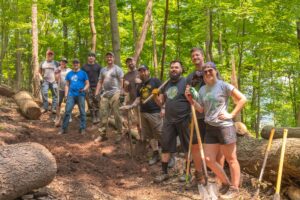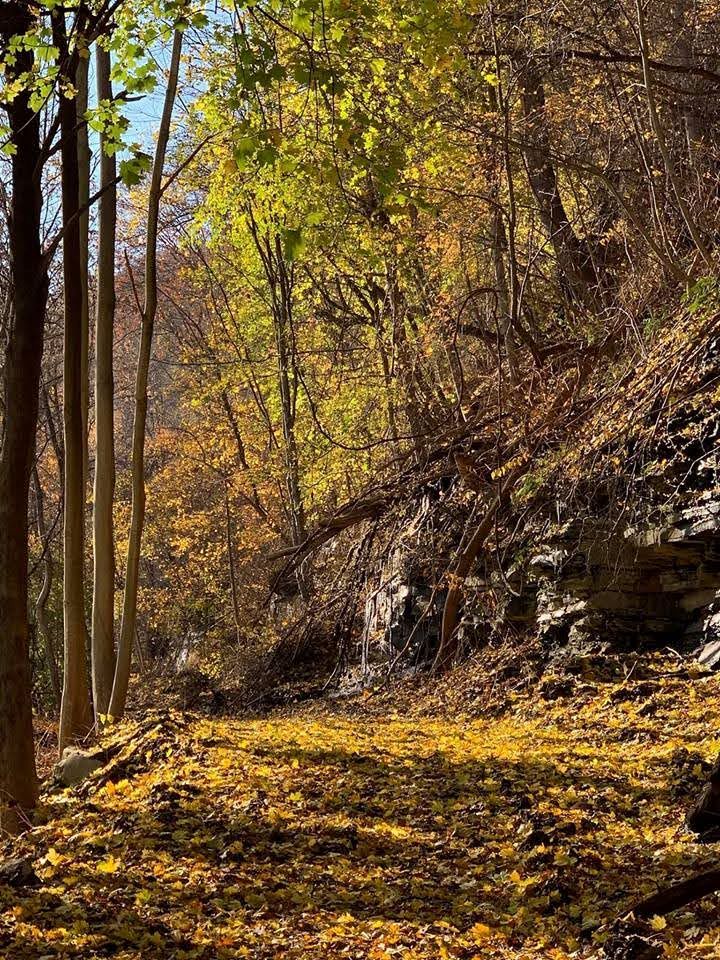Article and photos are shared courtesy of the author.
By: Michael Cook – Born and raised in Nanty-Glo, graduate of IUP, proud resident of Johnstown, and trail developer and maintainer of the Incline Plane Trails

Sculptor James Wolfe, Incline Plane Trail.
In Western Pennsylvania, on either side of the Johnstown Incline Plane lies an 80 acre park owned by the city of Johnstown. In the late 70’s, a series of hiking trails were developed that zig-zagged up the hill from the lower station to their terminus at Blair St in Westmont, less than a block from historic Grandview Cemetery, with another short trail that leads to the upper station on Edgehill Drive.
Those trails became the primer to developing a more robust trail system on the hillside, known as Yoder Hill. I was running over my lunch break one day and noticed a “To Trails” sign at the lower station. Intrigued by the potential for a new running route, I made my way across the metal walkway over to the old trail system. Over the next year or so I saw trees fall across the trails when the area experienced high winds. Washouts occurred every time we received heavy rain because the hillside is ridiculously steep AND the old drainage culverts were choked up with 40 years of debris. Even though it was considered a city park, the city didn’t have the public works resources necessary for their maintenance. These trails needed some love and some PR. Not many in the community knew they were there even though they are on the hill adjacent to the central business district.
 Almost serendipitously, my friend Dave Rasmussen, who is an engineer and avid mountain biker asked why trails were never developed for mountain biking on the hillside. It seemed like a no-brainer as the hill had the necessary elevation profile for really fun trails and was serviced by a lift in the form of the Inclined Plane that cost a fraction of what it would cost to get a lift pass at a resort with trails. He and I put together a comprehensive proposal for the city to consider. The proposal stated that we would maintain the existing hiking trails if the city allowed us to develop mountain biking trails separate from the hiking section. During the design and construction we would take into consideration the conservation of the landscape and the safety of riders by designing the trails to IMBA (International Mountain Biking Assocation) standards for grade and runoff, we would address existing areas where drainage and runoff was poor, we would treat knotweed overgrowth, and we would clear downed trees from the current trails. I took the proposal to the City Manager and he loved the idea. He had the city solicitor OK the whole thing and we were off to the trail building races.
Almost serendipitously, my friend Dave Rasmussen, who is an engineer and avid mountain biker asked why trails were never developed for mountain biking on the hillside. It seemed like a no-brainer as the hill had the necessary elevation profile for really fun trails and was serviced by a lift in the form of the Inclined Plane that cost a fraction of what it would cost to get a lift pass at a resort with trails. He and I put together a comprehensive proposal for the city to consider. The proposal stated that we would maintain the existing hiking trails if the city allowed us to develop mountain biking trails separate from the hiking section. During the design and construction we would take into consideration the conservation of the landscape and the safety of riders by designing the trails to IMBA (International Mountain Biking Assocation) standards for grade and runoff, we would address existing areas where drainage and runoff was poor, we would treat knotweed overgrowth, and we would clear downed trees from the current trails. I took the proposal to the City Manager and he loved the idea. He had the city solicitor OK the whole thing and we were off to the trail building races.
 In the fall of 2017 we officially kicked off trail building and maintenance. Our first task was to clear the existing trail of downed trees and remediate the drainage issues. Part of our agreement with the city included the removal of an old set of steps that led to the historic James Wolfe sculptures due to exposed rebar, and the installation of a metal gate over the opening to the old Rolling Mill Mine. Within four months, those tasks were completed. Next up, flagging and planning the bike trails. After trying to find a good location for a trail head, we settled on the corner of Tioga St and Edgehill Drive. The first phase included two trails that merged 1/3 of the way down the hill into another trail leading to the lower station. It took almost seven months to complete those trails.
In the fall of 2017 we officially kicked off trail building and maintenance. Our first task was to clear the existing trail of downed trees and remediate the drainage issues. Part of our agreement with the city included the removal of an old set of steps that led to the historic James Wolfe sculptures due to exposed rebar, and the installation of a metal gate over the opening to the old Rolling Mill Mine. Within four months, those tasks were completed. Next up, flagging and planning the bike trails. After trying to find a good location for a trail head, we settled on the corner of Tioga St and Edgehill Drive. The first phase included two trails that merged 1/3 of the way down the hill into another trail leading to the lower station. It took almost seven months to complete those trails.
 In September of 2018 we held a grand opening for the trails that included a downhill bike race to officially christen the trails. In the following months, the trails proved to be insanely popular. We only had three trails, but saw people riding every single weekend! It became apparent that some expansion was needed, so we mapped out another new trail further over on the hillside. Throughout that winter we worked diligently to get the new trail, J-Line, ready for the Spring reopening of the Inclined Plane. It was out longest trail to date and was made up of a number of flowy switchbacks down the hill. It was going to be our best trail yet. Early that spring, following the completion of J-Line we were smacked by Mother Nature, herself. A microburst (mini tornado) hit the Westmont area of the City. The microburst centered itself directly above J-Line. Tree tops were twisted off and deposited on the trail. Large 3 and 4 foot in diameter trees were piled on top of each other. I honestly thought about walking away from the project at that point, but something really amazing happened. The community, both cycling and my Johnstownian neighbors, rallied behind the project. Help turned out in full force chain sawing trees and resurfacing trails, and by some miracle, we opened the trail on time!
In September of 2018 we held a grand opening for the trails that included a downhill bike race to officially christen the trails. In the following months, the trails proved to be insanely popular. We only had three trails, but saw people riding every single weekend! It became apparent that some expansion was needed, so we mapped out another new trail further over on the hillside. Throughout that winter we worked diligently to get the new trail, J-Line, ready for the Spring reopening of the Inclined Plane. It was out longest trail to date and was made up of a number of flowy switchbacks down the hill. It was going to be our best trail yet. Early that spring, following the completion of J-Line we were smacked by Mother Nature, herself. A microburst (mini tornado) hit the Westmont area of the City. The microburst centered itself directly above J-Line. Tree tops were twisted off and deposited on the trail. Large 3 and 4 foot in diameter trees were piled on top of each other. I honestly thought about walking away from the project at that point, but something really amazing happened. The community, both cycling and my Johnstownian neighbors, rallied behind the project. Help turned out in full force chain sawing trees and resurfacing trails, and by some miracle, we opened the trail on time!
 Since then, we’ve added eight additional trails of varying difficulty, all cut by hand using a Rogue Rhino Hoe. All of the trails have been built using the high standards for erosion and runoff control. Clark’s Coconut Place Connector, will tie the trail system into the future 9/11 Memorial Trail System that will run from Washington DC to Shanksville, right through Johnstown. We never cut down a healthy tree for the sake of building a trail. The trails zig and zag because of this, but it’s worth it to promote a healthy forest. We’ve treated knotweed overgrowth in an attempt to encourage native species to populate the hillside. We’ve used the trail system to connect the City to nature and have hosted a number of events and clean up days for local school students and civic organizations. The Inclined Plane, owned and operated by the Cambria County Transit Authority, makes these trails one of the only trail systems in the country that utilized public transportation for lift access. They have been an amazing project partner and are currently rehabbing the incline plane which is set to reopen in the spring 2025.
Since then, we’ve added eight additional trails of varying difficulty, all cut by hand using a Rogue Rhino Hoe. All of the trails have been built using the high standards for erosion and runoff control. Clark’s Coconut Place Connector, will tie the trail system into the future 9/11 Memorial Trail System that will run from Washington DC to Shanksville, right through Johnstown. We never cut down a healthy tree for the sake of building a trail. The trails zig and zag because of this, but it’s worth it to promote a healthy forest. We’ve treated knotweed overgrowth in an attempt to encourage native species to populate the hillside. We’ve used the trail system to connect the City to nature and have hosted a number of events and clean up days for local school students and civic organizations. The Inclined Plane, owned and operated by the Cambria County Transit Authority, makes these trails one of the only trail systems in the country that utilized public transportation for lift access. They have been an amazing project partner and are currently rehabbing the incline plane which is set to reopen in the spring 2025.
Several years back, the City turned management of the property over to the Conemaugh Valley Conservancy. Their mission is to promote the conservation and preservation of natural, cultural, and historic resources. To encouraging prudent land practices in the Kiski-Conemaugh by restoring and enhancing land and water based natural resources. Also promoting citizen and environmental stewardship through low-impact recreation. Through the CVC we have engaged in projects to remediate an acid mine drainage discharge on the hillside, address several mine openings while preserving access for bats, and developed plans for a riverside park that will provide ADA access to the river for fishing and boating. Through the CVC we were able to accept the donation of an additional 9 acres of land near Millcreek Road. This allowed me to construct one of the final new trails, Grandview, which was designed specifically for newer riders to work on their cornering and descending skills. While the construction of new trails is done, the preservation of the natural resources we’ve been gifted in the form of this land, is far from over. Now we need to do everything we can to make sure future generations can enjoy and appreciate the park as much as we have been able to.




